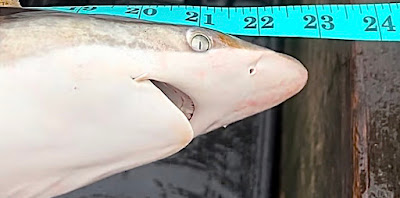Ocean State Shark Discovery: Rare Visitor or Sign of Change?
By Staff / ecoRI News
On the first day of September last year, Captain Carl
Granquist was fishing just south of Charlestown, R.I., when his catch landed on
the deck of his boat, the F/V Estrella Domar. A small shark he was unfamiliar
with was thrashing around.
The surprise visitor was measured and released.
(Atlantic Shark Institute)
Granquist wasn’t sure of the species. He videoed the shark
and measured the 24-inch species before releasing it. When Granquist shared the
video with the Rhode Island-based shark research group the Atlantic Shark
Institute to see whether it could make a positive identification, his unplanned
catch kick-started a dive that culminated in a research paper published
recently in the Journal of Fish Biology.
“Less than an hour after Granquist released the shark, I received the video and I was really surprised at the size and potential species of the shark,” said Jon Dodd, executive director of the Atlantic Shark Institute (ASI). “I knew it was one of two species of shark and either one would be a pretty unique find here in Rhode Island waters, particularly at only 24 inches in length.”
Dodd knew he was looking at either a spinner shark or
blacktip shark. Both species are well documented along the southeastern coast
of the United States and can be difficult to tell apart.
To assist in the identification, Dodd turned to Joshua Moyer
of Yale University and Stephen Kajiura of Florida Atlantic University, who is
also a member of the ASI’s Research Advisory Board.
Kajiura agreed identification was difficult, but noted that
such a young shark of either species in Rhode Island waters had rarely been
documented and was worth investigating. Moyer, lead author of the paper
documenting this find, reviewed the scientific literature for reliable
diagnostic criteria to identify the species in Granquist’s video.
“That was quite a scavenger hunt,” Moyer said. “These are
very similar species, and many historic works on sharks in New England either
admit that their identification of these sharks could be mistaken, or they do
not tell you how they made their identification.”
Ultimately, measurements along the snout were key for
species distinction, and using frame-by-frame analysis, Moyer confirmed Dodd
and Kajiura’s hunch that the shark in question was a spinner shark.
The waters of southern New England aren’t currently
recognized as nursery habitat for juvenile spinner sharks. Most documented
nursery habitat for spinners range from the Carolinas to Florida, according to
Moyer.
Whether nursery habitat is shifting northward because of
climate change or the shark in question is a rare stray, it’s too soon to tell,
according to Dodd. He noted a single shark doesn’t constitute proof of a
nursery.
“This discovery raises a number of really important
questions and it’s the very reason we do this critical research,” Dodd said.